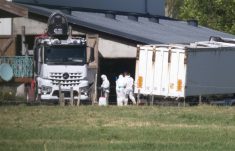Livestock producers in northwestern Alberta’s parched Peace River region have until April 29 to apply for AgriRecovery funds to move feed to livestock, or move livestock to feed.
What was dubbed Monday as the 2010 Canada-Alberta Feed Transportation Assistance Initiative is meant to cover a portion of the “extraordinary costs” for the region’s producers to move forage and feed to breeding herds, or to transport breeding herds to areas with a “more abundant” feed supply.
“Producers have seen first-hand the effects of more than a decade of unusually dry conditions in the Peace area,” area MLA and provincial Municipal Affairs Minister Hector Goudreau said in a joint federal/provincial release Monday.
Read Also

U.S. livestock: Cattle fall sharply as Trump says he’s working to lower beef costs
Chicago cattle futures fell sharply on Friday after U.S. President Donald Trump said his administration was working to lower the…
“The cost of transporting feed to the cattle or the cattle to areas that have adequate feed supplies can be prohibitive even for the best-managed operations,” Canadian Cattlemen’s Association president Travis Toews said in a separate release Monday hailing the governments’ announcement.
“This emergency assistance will help to somewhat ease the cost pressures of feed shortages caused by drought.”
Eligible producers who have to run up additional costs to transport feed to livestock will be eligible for transportation assistance of up to 22 cents per tonne or up to 10 cents per head per loaded mile.
Producers who must transport feed or breeding animals at least 25 km, up to a maximum 685 km, are eligible for a payment, the governments said.
Eligible Alberta counties include Grande Prairie No. 1, Birch Hills, Clear Hills, Northern Lights, Northern Sunrise and Saddle Hills; eligible Alberta municipal districts (MDs) include Big Lakes, Greenview No. 16, Smoky River No. 130, Spirit River No. 133, Peace No. 135 and Fairview No. 136.
Payments are to be based on the amount of eligible feed for consumption by breeding livestock within eligible areas, or the number of breeding animals transported from eligible areas, and the distance hauled “in excess of normal business practices.”
Breeding animals whose transport or feed transport is eligible for funding include beef cattle, bison, elk, deer, llamas, reindeer, sheep, goats, horses (meat or PMU only) or alpacas. “Breeding animals” are defined as females bred to produce offspring in 2011, or with offspring by side as of Jan. 1, 2011. The definition also includes male livestock of breeding age as of Jan. 1, 2011, either used in an applicant’s breeding operation in 2010 or meant to be used there in 2011.
The two governments on Monday estimated over 230,000 breeding animals are kept in the eligible areas. Said areas were determined “in consultation with the province” and using data such as precipitation levels, soil moisture levels, 2010 forage yields, estimated breeding herd sizes and determined feed shortages, the governments said.
Alberta’s provincial Agriculture Financial Services Corp. (AFSC) will administer the program and plans to send application forms to “known producers” in the affected areas. The forms are also available at AFSC district offices or online.















